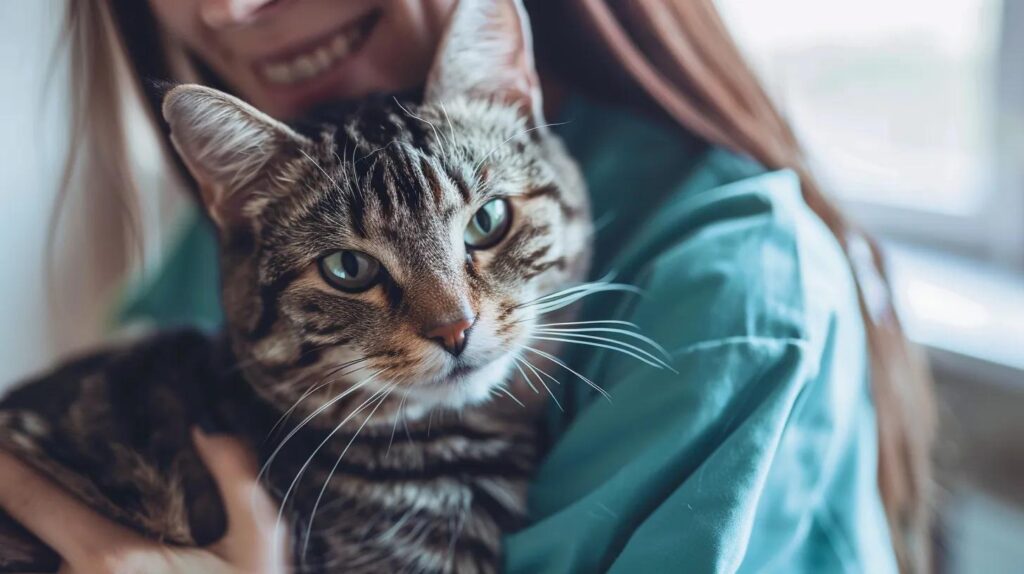
Caring for your feline companion involves much more than providing food and shelter. As experienced cat vet professionals in Thousand Oaks, we understand that comprehensive cat care requires attention to nutrition, health monitoring, grooming, and environmental enrichment. Whether you’re a first-time cat owner or have been sharing your home with cats for years, this guide will help you ensure your feline friend lives a long, healthy, and happy life.
At Slaton Veterinary Hospital in Westlake Village, we’ve helped countless cat families navigate the journey of responsible pet ownership. From essential daily care routines to recognizing when professional veterinary attention is needed, proper cat care forms the foundation of your pet’s wellbeing and strengthens the special bond you share.
Essential Cat Care Nutrition: Feeding Your Feline Right
Feline health begins with proper nutrition, and understanding your cat’s dietary needs is crucial for their overall wellbeing. Cats are obligate carnivores, meaning they require nutrients found only in animal tissue to thrive.
Choosing the Right Cat Food for Different Life Stages
Kittens require nutrient-dense foods with higher protein and fat content to support rapid growth and development. During their first year, kittens need approximately twice the nutrients per pound of body weight compared to adult cats. Look for foods specifically formulated for kittens and follow feeding guidelines carefully.
Adult cats benefit from balanced diets that maintain optimal body weight and support daily activities. Quality adult cat food should contain at least 26% protein and 9% fat on a dry matter basis. Cat nutrition experts recommend choosing foods with named meat sources as the primary ingredients.
Senior cats often require specialized diets that support aging organs and may have reduced calorie needs due to decreased activity levels. Senior cat care becomes increasingly important as cats age, requiring more frequent monitoring and potentially therapeutic diets. Regular cat health checkups help ensure proper nutrition as your feline friend ages.
Feeding Schedules and Portion Control
Establishing consistent meal times helps regulate your cat’s digestive system and prevents overeating. Most adult cats thrive on two meals per day, spaced 8-12 hours apart. Portion sizes depend on your cat’s age, weight, activity level, and the specific food you’re providing.
Free-feeding, where food is available all day, can lead to obesity and makes it difficult to monitor your cat’s appetite—an important health indicator. Measured meals allow you to track consumption and adjust portions as needed.
Hydration and Water Requirements
Cats have a low thirst drive compared to other animals, making adequate hydration a common concern in cat care. Fresh, clean water should always be available, and many cats prefer moving water from fountains or dripping faucets.
Wet food significantly contributes to daily water intake and can be especially beneficial for cats prone to urinary tract issues. Monitor your cat’s water consumption, as changes can indicate health problems requiring veterinary attention.
Preventive Health Care: Your Cat’s Medical Wellness Plan
Regular veterinary care forms the cornerstone of responsible cat care, helping detect and prevent health issues before they become serious problems.
Regular Veterinary Checkups and Vaccinations
Yearly vet inspections are essential for maintaining your cat’s health, even if they appear perfectly healthy. During these comprehensive examinations, your feline veterinarian will assess your cat’s overall condition, update vaccinations, and screen for common health issues.
Young adult cats typically need annual examinations, while senior cats benefit from twice-yearly checkups due to their increased risk of age-related conditions. These visits allow for early detection of problems like dental disease, kidney dysfunction, or diabetes.
Cat vaccinations protect against serious diseases and are tailored to your pet’s lifestyle and risk factors. Core vaccines for cats include rabies, feline distemper (panleukopenia), feline herpesvirus, and feline calicivirus. Your veterinarian may recommend additional vaccines based on your cat’s exposure risks. Learn more about our comprehensive cat vaccinations designed specifically for feline patients.
Parasite Prevention and Control
Cat parasite prevention requires year-round vigilance against both internal and external parasites. Fleas, ticks, and intestinal worms can significantly impact your cat’s health and comfort.
Regular flea prevention is crucial even for indoor cats, as these pests can be brought inside on clothing or other pets. Modern flea preventatives are highly effective and much safer than older treatments.
Internal parasites like roundworms, hookworms, and tapeworms are common in cats and can cause serious health problems if left untreated. Regular fecal examinations help detect these parasites early, allowing for prompt treatment.
Dental Care for Cats
Cat dental care is often overlooked but critically important for overall health. Dental disease affects over 80% of cats by age three and can lead to pain, tooth loss, and systemic health problems.
Daily tooth brushing represents the gold standard of home dental care, though many cats require gradual acclimation to this routine. Special cat toothbrushes and enzymatic toothpastes make the process easier and more effective.
Professional dental cleanings performed under anesthesia allow for thorough examination and cleaning below the gum line, where most dental disease occurs. Your veterinarian can recommend an appropriate schedule based on your cat’s individual needs. For cats requiring advanced procedures, our cat surgery capabilities ensure comprehensive care when needed.
Daily Cat Care Routines: Grooming and Hygiene
Cat grooming needs vary significantly between breeds and coat types, but all cats benefit from regular attention to their appearance and hygiene.
Brushing and Coat Maintenance
Short-haired cats typically need brushing once or twice weekly to remove loose hair and distribute natural oils. Long-haired breeds require daily brushing to prevent matting and tangles that can become painful and difficult to remove.
Regular grooming sessions provide opportunities to check for lumps, bumps, or skin changes that might indicate health problems. Many cats find gentle brushing relaxing and enjoy this bonding time with their owners.
Nail Trimming and Paw Care
Trimming your cat’s nails every 2-3 weeks prevents overgrowth and reduces damage to furniture and skin from scratching. Use sharp, guillotine-style nail clippers designed for cats, and trim only the white tips to avoid the pink quick containing blood vessels and nerves.
Providing appropriate scratching surfaces helps maintain nail health naturally and satisfies your cat’s instinctual need to scratch. Vertical and horizontal scratching posts with different textures appeal to various preferences.
Litter Box Management
Proper litter box maintenance is crucial for indoor cat care and your cat’s willingness to use their facilities appropriately. Scoop waste daily and completely change litter regularly based on the type you use.
The general rule is one litter box per cat plus one extra, placed in quiet, accessible locations. Avoid placing food and water near litter boxes, as cats prefer these areas separated.
Mental Stimulation and Exercise in Cat Care
Cat behavior and mental health significantly benefit from environmental enrichment and regular physical activity, especially for indoor cats.
Indoor Enrichment Activities
Puzzle feeders and food-dispensing toys encourage natural hunting behaviors while slowing eating pace. Rotating toys regularly maintains novelty and interest, preventing boredom that can lead to behavioral problems.
Vertical spaces like cat trees and shelving allow cats to survey their territory from elevated positions, satisfying their natural instincts. Window perches provide entertainment through “cat TV”—watching outdoor wildlife and activity.
Play Time and Bonding
Interactive play sessions using wand toys or laser pointers (always end laser play with a physical toy your cat can “catch”) provide essential exercise and mental stimulation. Most cats need 10-15 minutes of active play several times daily.
Play mimics hunting behaviors and helps maintain healthy weight while strengthening the bond between cat and owner. Schedule play sessions before meals to maximize your cat’s natural interest and enthusiasm.
Creating a Safe Environment: Cat-Proofing Your Home
Ensuring your cat’s safety requires identifying and eliminating potential hazards throughout your living space.
Common Household Hazards for Cats
Many common household items pose serious risks to cats. Toxic plants include lilies, azaleas, and poinsettias, which can cause serious illness or death if ingested. Research any plants before bringing them into cat-accessible areas.
Household chemicals, medications, and small objects that could cause choking or intestinal blockages should be stored securely. String, ribbon, and similar items are particularly dangerous as they can cause life-threatening intestinal obstructions.
Indoor vs. Outdoor Cat Care Considerations
Indoor cat care significantly extends feline lifespan by eliminating risks from vehicles, predators, diseases, and other outdoor dangers. Indoor cats live an average of 13-17 years compared to 2-5 years for outdoor cats.
For cats that enjoy outdoor experiences, supervised time in secure enclosures or on leashes provides enrichment while maintaining safety. Many cats adapt well to harness training when started gradually and patiently.
Recognizing Signs of Illness: When Cat Care Requires Professional Help
Understanding when your cat needs immediate veterinary attention can be life-saving and prevents minor issues from becoming major problems.
Behavioral Changes That Signal Health Issues
Changes in eating, drinking, or elimination habits often indicate health problems requiring professional evaluation. Increased water consumption might suggest diabetes or kidney disease, while decreased appetite can signal various medical conditions.
Lethargy, hiding, or changes in social behavior often precede obvious physical symptoms. Cats instinctively hide illness, making behavioral changes particularly important indicators for attentive owners.
Physical Symptoms to Monitor
Weight changes, whether gain or loss, should prompt veterinary consultation. Regularly feeling your cat’s body during grooming helps you notice changes in muscle mass or the presence of unusual lumps.
Breathing difficulties, coughing, or changes in mobility require immediate attention. These symptoms can indicate serious conditions requiring prompt emergency cat care.
Emergency Situations
Certain situations require immediate veterinary attention, including difficulty breathing, inability to urinate, severe trauma, or ingestion of toxic substances. Having your veterinarian’s clinic nearby ensures that your cat will be able to be treated quickly in the event of an emergency.
Cat emergency care facilities should be identified before you need them. Know the location and hours of your nearest emergency clinic, and consider discussing emergency protocols with your regular veterinarian.
Building Long-Term Cat Care Habits for Lifelong Health
Successful cat care involves establishing sustainable routines that promote health throughout your pet’s life stages.
Creating Sustainable Care Routines
Daily tasks include feeding measured meals, providing fresh water, scooping litter boxes, and spending quality interactive time. Weekly responsibilities include nail trimming, thorough grooming sessions, and environmental cleaning.
Monthly tasks might include weighing your cat, examining them thoroughly for changes, and reviewing their behavior patterns. Annual responsibilities include veterinary examinations, vaccination updates, and reassessing care routines as your cat ages.
Involving family members in cat care responsibilities ensures consistency and helps everyone recognize changes that might indicate health problems. Children can participate in age-appropriate tasks while learning responsibility and compassion.
Consider cat microchipping as a permanent form of identification. Learn more about microchip benefits and procedures to keep your feline family member safe.
Conclusion
Comprehensive cat care encompasses nutrition, preventive healthcare, grooming, environmental enrichment, and safety considerations. By establishing consistent routines and maintaining regular veterinary care, you’re investing in your cat’s long-term health and happiness.
Remember that every cat is unique, and their care requirements may change throughout their lives. Stay observant, be flexible in adapting your care approach, and don’t hesitate to consult with veterinary professionals when questions arise.
Ready to Give Your Cat the Best Care Possible?
As your trusted Thousand Oaks veterinary team, we’re here to support you and your feline companion through every stage of life. From kitten care to senior cat care, our experienced team provides the expertise and compassion your cat deserves.
Located at 3900 E. Thousand Oaks Blvd, Suite 101, Westlake Village, CA 91362, we’re your neighborhood’s trusted Ventura County Veterinarian committed to exceptional feline healthcare.
To learn more Call Us (805) 269-6696 or schedule a visit today!




